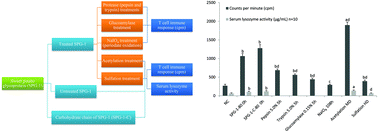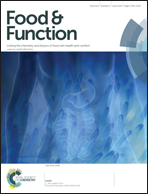Immune activity of sweet potato (Ipomoea batatas L.) glycoprotein after enzymatic and chemical modifications
Abstract
This study aimed to investigate the immune activity of sweet potato (Ipomoea batatas L.) glycoprotein (SPG-1) before and after enzymatic and chemical modifications. The protein portion of SPG-1 was modified by pepsin, trypsin, and acetylation treatments. The carbohydrate portion was modified by glucoamylase, NaIO4, and sulfation treatments. The carbohydrate chain of SPG-1 (SPG-1-C) was obtained. Immune activity was analyzed by measuring the serum lysozyme activity and T cell immune response. SPG-1 increased immune activity with a dose–response effect. Immune activity was slightly decreased after pepsin and trypsin hydrolysis, whereas it increased after a moderate degree (DS = 0.68) of acetylation. Immune activity was partly decreased after glucoamylase hydrolysis, remarkably decreased after NaIO4 oxidation, or was lost after a high modification by sulfation. Compared with SPG-1 groups, the SPG-1-C groups increased immune activities had insignificant (P > 0.05) differences. Hence, appropriate modifications of the protein portion could be conducted and it was found that high modifications of the carbohydrate portion should be avoided to improve or maintain the immune function of SPG-1.


 Please wait while we load your content...
Please wait while we load your content...